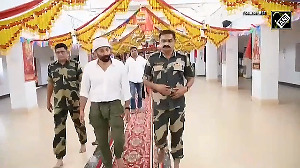Every year Pakistan celebrates February 5 as Kashmir Day. This year, there was growing pressure amongst intellectuals in advising the Pakistan government to rethink its Kashmir policy and break out from the straitjacket of 'Kashmir or nothing.'
Many columnists including well-known Pakistani columnist M B Naqvi had written about this. In fact, he had demanded a new India policy.
Similarly, former president of Pakistan occupied Kashmir and chairman of the Pakistan Kashmir Committee Sardar Qayyum Khan in January had advocated the need for talks with India on converting the Line of Control as the border.
This is reportedly at the behest of both President Pervez Musharraf and the Zafarullah Jamali government, probably as a trial balloon though the report was denied.
The significance of rekindling the idea should not be lost in the static of cross-border terrorism. This is the line that the late Zulfiqar Ali Bhutto once called the Line of Peace.
The LoC is history's longest unsettled line despite India's stunning military victory in 1971. The proxy war in J&K was started in July 1947 by tribal raiders under Major General Akbar Khan in order to preempt Maharaja Hari Singh from acceding the state to India.
The war between two dominions, orchestrated by the British, had one objective -- all of J&K should not go to India. As the first Indian Commander-in-Chief General K M Cariappa was to take over on January 15, 1949, the British hassled Jawaharlal Nehru into accepting a ceasefire on December 31, 1948.
The ceasefire line and the UNMOGIP [UN Monitoring Group in India and Pakistan] were born on that day. The 760 km CFL stretching from Manawwar in Chhamb to below Siachen Glacier up to NJ 9842 and 'thence northwards to the glaciers' was demarcated in Karachi on July 17, 1949.
The 17-day 1965 war could not alter the character and nomenclature of the CFL despite Russian Prime Minister Alexei Kosygin's efforts at Tashkent to persuade General Ayub Khan to make CFL into an international border. Lal Bahadur Shastri even offered a no-war pact to Pakistan for respecting CFL and ending infiltration. All territories captured including Haji Pir and Kargil heights (captured twice by Indian forces in six months) had to be returned to Pakistan.
In 1971 neither side returned territory seized across CFL and so Kargil's Point 13620 came back to India. On August 10, 1972, Lieutenant General P S Bhagat and Lt Gen Abdul Hamid Khan met at Suchetgarh to re-demarcate the CFL as on December 17, 1971 where it had been disturbed rather than a new more viable line.
The CFL becoming the LoC and derecognition of UNMOGIP were byproducts of this war. Unfortunately the Indian side omitted to extend the LoC beyond NJ 9842 along the Saltoro Ridge up to the Karakoram Range. Field Marshal Sam Maneckshaw has called this as strategic oversight.
The inability to force the conversion of LoC into an International Border was essentially a political and diplomatic failure. Neither the 90,000 Prisoner of Wars nor the huge swathe of captured Pakistani territory could be used to force Prime Minister Zulfiqar Ali Bhutto into committing on paper, the conversion of LoC into an IB. Bhutto was able to wriggle out of the separate nets cast by Indira Gandhi and the first prime minister of Bangladesh, Mujibur Rehman.
Pakistan-India relations normalised in 1976 after repatriation of prisoners and land, settlement of war related issues except the alteration of the LoC into IB. Sadly the 'secret agreement' strongly refuted by Pakistan died in 1977 when both Gandhi and Bhutto went out of office.
Later, Bhutto was hanged in 1979 and in 1984, Indira Gandhi was assassinated. From 1976 to 1984, the LoC was peaceful. It hotted up after Siachen happened in 1984 and later in 1989 blew up into the third proxy war.
But much before 1971, the earliest attempt to convert the CFL into IB was made after the 1962
Himalayan blunder in a US-initiated dialogue between then foreign minister Sardar Swaran Singh and the ubiquitous Bhutto. They held marathon sessions spread over months. Yet an agreement eluded them.
Armed with marked maps, India had even agreed to give them 3,000 sq miles of territory which did not include the 2,000 sq miles of Northern Areas ceded by Pakistan to China in 1963. It could have been Swaran Singh's golden hour as he all but clinched the deal. Bhutto rejected it but it is more likely that a political consensus was unavailable in India on this immediately after the humiliating defeat at the hands of the Chinese.
Pakistan has deliberately kept the LoC hot and sponsored cross-border terrorism to keep alive the
issue of J&K, the demand of self determination and plebiscite. Not surprisingly therefore, in 1999, the Pakistan army launched yet another clandestine operation to alter the disposition of LoC, avenge India's preemptive occupation of Siachen in 1984 and internationalise a nuclearised J&K.
The 70-day Kargil war ended with Indian forces vacating aggression and restoring the sanctity of the LoC. For India, the LoC is the Holy Grail and much of its present difficulties regarding 'preemptive action' stem from the need to respect the LoC.
General Pervez Musharraf has frequently repudiated Indian allegations of cross-border terrorism by pointing out terminological inexactitude: it is the LoC, not border; a freedom struggle not terrorism.
India's deliberate and sustained use of the word 'border' should not be missed. The case for converting CFL/LoC into IB is a case of missed opportunities. Both in the 1947 and 1965 wars, but for the premature acceptance of ceasefire, the Indian Army was confident of retaking PoK. After winning the 1971 war, India lost out on forcing a vanquished Bhutto into settling the LoC as the IB.
Many Western think tanks have periodically floated the idea of making LoC into a border. Both sides have to surmount obstacles to do so. For Pakistan the Kashmir masla resurfaced in 1989 due to Indian misgovernance in J&K. 'Previously it was not on our radar,' observe Pak analysts, 'it has now been turned into a core issue,' while for India it is the core of Indian nationhood.
Pakistan is apparently willing to sacrifice the wellbeing and happiness of 140 million Muslims for the 4 million Muslims in Kashmir. An army of fidayeen and jihadis supported by the ISI is waging a relentless terror war no longer under Musharraf's control. By giving up the Kashmir cause, (read the India threat) the Pakistan army will lose the raison d' etre for its primacy in state and society.
India's difficulties are less intractable: to renege on a parliamentary resolution of 1993 to retake PoK. This is similar to the 1962 resolution to retake territory lost to China. India must be seen as a rather careless nation, losing land to neighbours. There is also a prime ministerial resolution from the ramparts of the Red Fort in 1994 to 'complete the unfinished agenda of the Partition.'
Article 253 of the Constitution stipulates that any settlement of J&K would first have to be approved by the state assembly. By now we are all tired of listening to our leaders about ending terrorism permanently and decisively. It is clear to them and to the readers that this is not possible till Pakistan is comprehensively defeated in war or agrees to comply either on its own or through friendly persuasion.
The starting point for that is to begin putting the J&K house in order and simultaneously start the dialogue on Kashmir. It is believed the US and most of the international community favour the proposal of making the LoC with certain adjustments into a soft border. The redemarcated border would have to be as agreed in Simla, more rational and viable.
There is mounting pressure on Pakistan by the US, UK and Russia to end cross-border terrorism as promised by Musharraf. Both the US ambassadors in Delhi and Islamabad have explicitly asked Pakistan to do so.
Time is on India's side. The two sides have to start a dialogue seriously on turning the LoC into a border. For this the first step has to be a ceasefire on the LoC, followed by an end to cross-border terrorism. US Ambassador Robert Blackwill has said the war on global terrorism can never be deemed won till cross-border terrorism against India is ended.
The four or five long steps, not necessarily sequential, to making LoC into a line of peace and the
IB could be:
- Ending cross border terrorism
- Ceasefire on the LoC
- Ceasefire with indigenous militant groups
- Isolating foreign terrorist groups
- Dialogue
The first India-Pakistan Track II dialogue following the confrontation of last year is to be held in Kathmandu in March, under the aegis of the Friedrich Ebert Stiftung, a German think tank. No doubt converting the LoC into IB will be one of the models for a way out of the current impasse.






 © 2025
© 2025